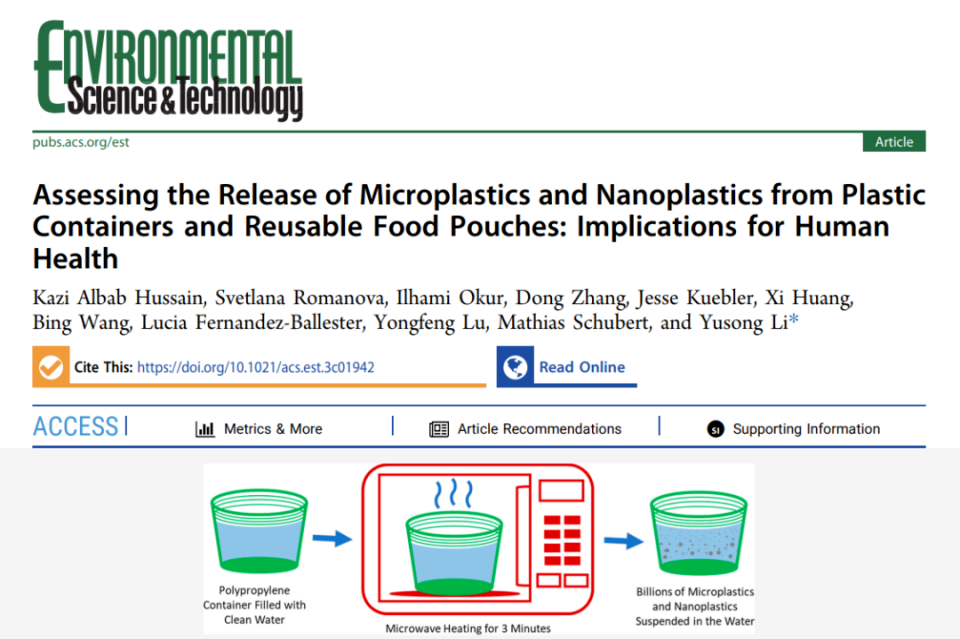Microwave ovens are found in almost every home. It is very convenient for people to use it to heat up rice, hot dishes and so on. However, it is recommended that after reading this article, we try not to use plastic plates and bowls to put into the microwave oven to heat up in the future.
Heating for 3 minutes releases billions of plastic particles from plastic food containers
In July 2023, a study on the release of microplastics and nanoplastics from plastic containers in different usage scenarios was published in the "Environmental Science & Technology" journal. The research findings revealed that compared to storage at refrigeration or room temperature, microwave heating resulted in the highest release of microplastics and nanoplastics into food. It was observed that over 2 billion nanoplastics and 4 million microplastics were released per square centimeter of the container during microwave heating.

Researchers selected "food-grade plastic containers" composed of polypropylene and polyethylene, heated them in a microwave for 3 minutes, and analyzed the liquid inside the containers. They found numerous microplastics (with a diameter of approximately 1 micron) and even smaller nanoplastic particles. It was estimated that heating 1 square centimeter of plastic could release 4.22 million microplastic particles and 2.11 billion nanoplastic particles.
The study also revealed that when plastic containers were used for heating liquids such as water or milk, the highest concentration of microplastic particles was generated. In contrast, if the containers were only used for the refrigerated storage of food or beverages, the released microplastics were significantly fewer.
Therefore, it is advisable to avoid using plastic containers when heating food in the microwave in daily life.
We have detected microplastics in these parts of our bodies
Plastic products have become indispensable in people's production and daily lives. However, the widespread use of plastic products also increases the risk of microplastics entering the body.
Microplastics are difficult for the human body to metabolize and absorb. The portion that is not excreted may accumulate in the body, and exceeding a certain amount may lead to damage to organs and cells to varying degrees. What is even more shocking is that scientists have discovered the presence of microplastics in multiple organs of the human body.
1. Brain
In April 2023, a study published in "Nano Materials" by an international scientific team revealed that new research on mice indicates that microplastic particles can pass through the blood-brain barrier and enter the brain within just 2 hours after being ingested.

Some microplastic particles can penetrate the intestinal barrier and the blood-brain barrier in a relatively short period. Researchers suggest that plastic particles in the brain may contribute to inflammation, neurological disturbances, and even increase the risk of neurodegenerative diseases such as Alzheimer's or Parkinson's.
2. Blood
In 2022, a study published in the reputable journal "International Environment" revealed the presence of microplastics in the blood of participants. This implies that microplastics may be widespread in various organs of the human body, posing significant health risks.
3. Gastrointestinal System
In 2018, the European Society of Gastroenterology reported for the first time the detection of up to 9 types of microplastics in human feces, with diameters ranging from 50 micrometers to 500 micrometers. Microplastics can reach the human gastrointestinal system and may affect the digestive system.
4. Lungs
An article published by Li Mingju and colleagues from the School of Public Health, China Medical University, in the 2022 issue of "Chinese School Health" pointed out that air sampling in a human model showed that a mildly active male could inhale close to 300 microplastic particles daily. Pathological examinations in cancer tissues of lung cancer patients and adjacent lung tissues revealed the presence of cellulose and plastic microfibers.
5. Placenta
A study published in 2020 in the authoritative journal "International Environment" revealed that researchers detected "microplastic particles" ranging from 5 to 10 micrometers in size in the placentas of four out of six healthy pregnant women. This indicates that microplastics can impact the human body through the placental barrier.
To reduce microplastics, here are a few things to avoid in daily life:
To reduce the risk of microplastics entering the body, here are a few things to avoid in daily life:
1. Minimize the use of plastic containers for microwaving.
Despite many plastic containers being labeled as "food-grade," they can still release plastic particles under microwave heating conditions.
2. Reduce the use of plastic products for storing food.
The mentioned research also indicates that, while using plastic containers to store or refrigerate food releases fewer plastic particles compared to microwaving, there is still a potential for release.
3. Limit the use of disposable plastic cups and straws.
Minimizing the use of disposable plastic cups, plastic water bottles, and plastic straws can reduce the risk of microplastics entering the body.
4. Minimize the use of disposable utensils and takeout containers.
When dining out or ordering takeout, try to avoid using disposable utensils and takeout containers. You can bring a glass or metal container to use for takeout, preventing heated food from coming into contact with plastic products.
5. Avoid littering used plastic items.
Don't litter plastic bottles and plastic bags. Dispose of them properly by sorting waste into designated bins for recycling, reducing environmental pollution and preventing microplastics from entering the human body through the food chain.
Related Products
























